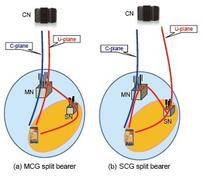
5G NR Security: Key Derivation and Termination Points
Explore 5G NR security basics including key derivation algorithms and security termination points for user data and signaling.
Showing 20 posts (Page 4 of 9)
Advertisement

Explore 5G NR security basics including key derivation algorithms and security termination points for user data and signaling.

Explanation of 5G NR slot formats, defining downlink, uplink, and flexible symbol allocation within a slot as per 3GPP TS 38.200.

Explore the key differences between 5G NR spectral and energy efficiency, including formulas and explanations based on the 3GPP standard.

Understand 5G NR split bearer functionality in dual connectivity (DC) mode. Learn key concepts like master node, secondary node, and data splitting for enhanced throughput.
Calculate the 5G NR Transport Block Size (TBS) using formulas and equations from the 5G NR 38.214 standard, considering factors like Qm, R, v, and the number of Resource Elements (REs).

Explore the differences between Transport Block Size (TBS) and Code Block Group (CBG) in 5G NR, including UE procedures for grouping code blocks.

Calculate 5G NR throughput using our calculator and understand the formula behind it, based on 3GPP specifications.
Explore the critical 5G NR timers T304, T310, and T311, focusing on their functions and the constants N310 and N311.
An overview of User Equipment (UE) identities used in 5G New Radio (NR) networks, covering IMSI, IMEI, SUPI/SUCI, GUTI/S-TMSI, RNTI and I-RNTI.

Understand 5G NR UE power classes (1, 2, 3, 4) with EIRP and output power limits for user equipment based on 3GPP standards.

Learn about the three RRC states in 5G NR: RRC_IDLE, RRC_INACTIVE, and RRC_CONNECTED. Understand the functions of the RRC layer and the actions performed by the UE in each state.

Explore 5G NR search space types (Type0, Type0A, Type1, Type2, Type3) and UE-specific search spaces. Understand the RRC Search Space Information Element (IE) and its role in PDCCH monitoring.

Understand the 5G NR uplink power control procedure for PUSCH, PUCCH, SRS, and PRACH channels. Learn about open loop, closed loop control, and relevant information elements.

Explore 5G NR physical layer parameters: FFT size, sampling time, subcarrier spacing, symbol length, and their relationships as per the 3GPP standard.

Explore the benefits and drawbacks of 5G OpenRAN, including reduced costs, increased flexibility, and potential performance limitations.

Explore the fundamentals of Over-The-Air (OTA) testing for 5G NR, including requirements, test methods, and Rohde & Schwarz solutions for accurate and efficient measurements.

Explore the 5G protocol stack, including the functions of Layer 1 (Physical), Layer 2 (MAC, RLC, PDCP), and Layer 3 (RRC).

Explore the distinctions between Primary Synchronization Signal (PSS), Secondary Synchronization Signal (SSS), and Extended Synchronization Signal (ESS) in 5G technology for frame synchronization.

Explore the applications of 5G Radio Dot in enhancing indoor coverage and delivering high-speed connectivity in 5G networks. Learn about its key features.

Understand the causes and phases of 5G Radio Link Failure (RLF) in 5G User Equipments (UEs), including failure at lower layers and during handover.
Advertisement